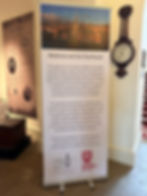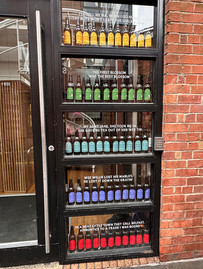Belfast - Much More Than The Pubs and The Troubles
- debbiemanderson1
- Apr 18, 2024
- 11 min read

You can be forgiven if your knowledge of Belfast in Northern Ireland is limited to the pubs and The Troubles.
We were in for one big surprise. I soon pronounced Belfast one of my favourite smaller cities. Remember the workplace trend to develop ‘word clusters’ to describe values or visions? If I think of Belfast, the following words come to mind: energetic, kind, progressive, historic, quaint, modern, helpful, humourous, optimistic, proud, contrasting, creative, poetic, charismatic, fun, quirky, and developing.
Belfast is a port city on the northeast coast of Ireland, connected to the Irish Sea and eventually the Atlantic Ocean. It’s a small city with only about 346,000 people in the city proper and about 672,000 if you include the larger area.
We arrived in Belfast after a short 55 minute flight from London. Our immediate impression was one of kindness and friendliness - from the fellow on the train platform ensuring we knew which train to take into the centre and how to pay when there was no pay station, to the young lady who did our laundry at the laundromat while we drank coffee, to the fellows at the cafe who asked us to “do a favour” and sample a free piece of cake - and this all occurred within the first hour of our time in Belfast. And we soon learned that, unless you have time to spare, don‘t engage a Belfast local because they can sit and talk for hours with plenty of advice and help.
We stayed for four nights in the south of Belfast city centre, in the small Tara Lodge, just blocks away from the historic and stately Queen’s University and the adjacent beautiful Botanic Gardens which define the southern edge of the downtown. This was an ideal location to walk to the central core which is a combination of ‘tradition’ and ‘new’, the historically troubled west side, and the modern and developing Lagan riverway on the east side of downtown. You don’t need public transit as the city is so small, but trains and ‘Glider’ busses are available. Walking maps are available on line.

Queen’s University dates to 1845 and is ranked in the top 200 universities in the world.

The Botanic Gardens cover 29 acres and contain flower gardens, tropical plants, a conservatory, bird feeders, and a rose garden. The Garden also houses the Ulster Museum which is on our ‘next time’ list.
The centre of Belfast is small and easily navigable. Belfast City Hall, dating to 1906, is the centre point and a magnificent building. It has a grand entrance and staircase, stained glass windows, and extensive marble that feels soft and smooth to the touch. It also has 16 rooms of Belfast history, free to tour. The Bobbin Cafe is a non-profit coffee shop providing skills to people with disabilities. The building is surrounded by lawn, gardens, and statues, including a war memorial and Titanic memorial.


The Europa Hotel describes itself as “world famous” and, over 50 years, was made notable by celebrity guests including Elton John, Bill and Hilary Clinton, Sting, U2, Lady Gaga and many others. The clerk advised he has worked there for 30 years and has met them all.

The Grand Opera House has been Belfast’s main theatre for over 100 years. The lineup of shows for the coming year is diverse, everything from Chitty Chitty Bang Bang to Bonnie and Clyde to Tina The Musical.
One building that is noteworthy, both for the physical space and the purpose, was the Royal Avenue cultural centre. This was formerly the Provincial Bank of Ireland and then a Tesco grocery store before being purchased by the City as an all-purpose, non-profit centre for everyone of all ages and abilities. It houses art exhibits, craft corners, meeting spaces, play stations, relaxation areas, a small cafeteria, sensory rooms, independent study or work rooms, and a grand piano. The building has a beautiful dome supported by columns and many interesting sculptures tucked in the ceiling that all tell a story. ‘Paul’ gave us our own private tour with much information about the history of the building and the purposes of the centre.
A fun-focussed day in Belfast might involve discovering all the little passageways in Central Belfast that are now being redeveloped as shopping or social areas. The most popular is Commercial Court in the Cathedral District, now lined with pubs (including the popular Duke of York) and decorated with sturdy umbrellas which provide great photo ops on a rainy day. Commercial Court was once Belfast’s main commercial quarter. I loved the poetry here (and all over Belfast).

A lesser-developed passageway:

The Ulster University’s modern buildings on the edge of the Cathedral Quarter are a contrast to the stately Queens University in the south. It has an interesting history as it was formed in 1984 after a review of higher education in Northern Ireland determined the need for another modern educational facility.

On the northern edge of central Belfast sits the interesting Clifton House which was Belfast’s original ‘poor house’. It was opened in 1774 by the Belfast Charitable Society which continues to ensure that the building remains dedicated to helping those in need. Today, besides offices and meeting rooms, it provides some low income housing and a dementia unit. The lobby holds an intriquing display of old medical supplies which now seem archaic.


Belfast has plenty of colour to add to its charm and to contrast the more elaborate buildings. Another fun ‘theme’ day might be to find as many colourful storefronts as you can find - they are unique and quaint. Here’s just a sample.
The Lagan riverway is under development as part of the rejuvenation of Belfast. A must-see is Thanksgiving Square, not because the square itself is spectacular but because of the 19 metre bronze Beacon of Hope statue that so aptly represents the new direction for Belfast. Built in 2006, a female figure holding a large ring stands on a globe that represents the universal desire for peace, harmony, and thanksgiving. (Of course, with the great Irish humour, the statue is also known as the Doll With The Ball, Nuala With The Hula, The Belle On The Ball, The Thing With The Ring . . . regardless, it symbolizes Belfast’s desire to move forward.)

You also can’t miss the 32 foot long Salmon of Knowledge or simply ‘The Big Fish’ on the Lagan riverway. It was built in 1999 and is based on an Irish legend about a fish that had acquired wisdom. It’s not just a big fish, though. Each shiny scale tells something of Belfast’s history and, of course, if you kiss its lips, you also acquire wisdom.

Close to the Big Fish is the Albert Memorial Clock, a much older Belfast landmark, completed in 1869 and standing 113 feet tall. It is a bit tilted, leaning about four feet, due to being built on soft ground. A clock that old certainly has some stories attached, worth researching. Why did it stop ticking? Who used to ply their trade under the clock? Why did it lose time?

The Gasworks area on the waterway appears to be one of the newest developments, an area of housing and business. It is where Belfast produced gas from 1822 to 1985 and is a great place to enter the river pathway system (you can walk for 17 kilometres on the Lagan Towpath, if you like). This is the gasworks clock and the Bottle Cap statue.
What about those pubs and the drinking culture that we tend to associate with Belfast? Pubs do have a longstanding tradition in Irish culture, cozy places for camaraderie, belonging, and relaxation - and Belfast has many, seemingly on every corner. And everyone has their favourite - they’ll be quick to tell you. The Healthy Ireland Survey revealed that although alcohol consumption has decreased considerably, especially amongst younger generations, it remains a concern. The Public Health Alcohol Act has helped to reduce usage with restrictions such as minimum alcohol prices. We saw signs all over Belfast stating that ‘alcohol is not to be consumed in this location’ (or something to that effect). Campaigns are encouraging alternate sources of entertainment and leisure to curb unhealthy usage. Thejournal.ie “alcohol consumption levels have decreased in the last five years, survey finds” is a good article. So, enjoy one of the historic pubs, but maybe share a pint or go for a non-alcohol Guinness which is available. Here are two of the most famous:
The Crown Bar dates to 1826 and is one of Northern Ireland’s most well-known pubs. Interestingly, it was built by Italian craftsmen (after regular work hours) who were working on new churches in Belfast at the time, so The Crown was known as a fine Victorian ‘gin palace’. It is now owned by the National Trust and renovated to its original status. Many movies have been produced here.

The Sunflower is young, although many other pubs sat on this location in the hundred years before it opened in 2012. The Sunflower is described as a simple corner pub. What stands out, though, is the green ‘security’ cage at the front entry which was installed during The Troubles after a shooting took place inside the pub. With the cage, the bartender could see who was about to enter and decide whether or not to let that person in. Although development authorities at one time apparently wanted the cage removed, the owners (and patrons) lobbied, and it remains as part of Belfast’s history.

Other prominent Belfast pubs include Kelly’s, The Duke of York, Bittles, The Merchant (but, as one fellow told us, check your bank account first if you go there) . . . the list goes on. There are almost 800 pubs in Northern Ireland alone, according to Hospitality Ireland, although there has been a decline in the number of pubs in the past 20 years.
Any British or European city would simply not be a true British or European city without some massive cathedrals. The most prominent in Belfast is St. Anne’s or the Belfast Cathedral dating to 1899 that dominates the Cathedral Quarter in the central area.
Others we visited were:
St. Patrick’s from 1877:
St. Malachy’s from 1844:
St. George’s from 1816:
St. Peter’s, from 1866, on the west side:
And the Clonard Monastery, from 1911, also on the west side:
By the late 1800’s, Belfast had become known for its industry. It was a world leader in linen production, and other industries included engineering, rope-making, tobacco manufacturing, and whiskey distilling. But it also had the world’s largest shipyard which allowed for exports and shipbuilding. On the east shore of the Lagan River is the recently-developed Maritime Mile walk, showing off Belfast’s dockyards, a ship under construction, a movie production set, a whiskey distiller, and a naval ship. This is the home of two mammoth cranes, Samson (348 feet, built in 1974) and Goliath (315 feet, built in 1969) that stand out on the skyline and, when built, were seen as faith in the future of Belfast’s dockyards.

But, of course, one of Belfast’s most well-known productions (resulting in one of the best museums we have encountered) was the Titanic. The Titanic Belfast Museum on the Maritime Mile explains in detail how the Titanic came to vision based on the economy and thinking of the times, the production, the launching, and the ill-fated maiden voyage. As the tour ends, it explains that Belfast can finally be proud of its accomplishment (rather than embarassed) as the Titanic was certainly a massive engineering feat and contributed to the city’s arts and creativity with its luxuriousness.



A unique concept on the Maritime Mile is the Dock Cafe. The Dock Cafe is a non-profit, no charge, pay-as-much-as-you-want cafe on the waterfront. It’s been in operation for 13 years, has only one paid employee (the rest are volunteers), has delicious baking, and provides food to the disadvantaged.
Do you remember the Lion, The Witch, and The Wardrobe? While you are on the far east side, you might want to step into fantasyland at the Eastside Visitor Centre on C. S. Lewis Square (also within walking distance). C. S. Lewis (‘Jack’ to locals) is described as the east side’s most famous author. Visit the square and hunt for the seven bronze statues that will make you feel that you, well, have walked through the wardrobe.
Belfast is rich with culture and is littered in a good way with street art and poetry. Here’s a sample. (Unfortunately, we did not partake in any true Irish music, but we still have three Irish cities on our itinerary.)
You might wonder why I did not lead with the well-known history of conflict and ‘The Troubles’ as that has been so much of what we westerners have learned of Belfast. This was purposeful as I received the distinct impression that this city, for the most part, is simply focussed on moving forward. You, of course, can’t deny the turmoil as it has had a lasting impact on the city, even spurring on it’s current desire and energy to move forward and define itself to the world as a city that is known for much more than just conflict and problems.
I have to say that I do not understand The Troubles, and even the locals will say it is ‘complicated’. I decided to read from a hopefully neutral source, Peacekeeper, emu.edu, (A Brief History of “The Troubles”). It appears the conflict goes back centuries when Ireland came under British rule. Large numbers of English and Scottish (mostly Protestant) settled in Nothern Ireland where the majority of native Irish were Catholic. In the early 1920’s, Britain divided Ireland, keeping Northern Ireland for itself and letting the rest of the country be independent. The conflicts that arose had to do with the nationalist (mostly Catholic) population wanting to join Ireland and the unionist (mostly Protestant) population wanting to remain within the UK. But it appears there were many issues within the broader dispute relating to equality, rights, culture, justice, etc. The heaviest conflict occurred in the early 1920’s and then for three decades from the 1960’s until the Good Friday Agreement was signed on April 10, 1998. Again, I don’t even pretend to understand this conflict, so be sure to do your own research.
So, to try to understand this situation better, we joined the ‘Conflicting Stories’ three-hour tour in west Belfast, the first half conducted by a former member of the nationalist Irish Republican Army and the second half by a former member of the unionist side. The tour took us along the Shankill Road (mostly Protestant) and Falls Road (mostly Catholic) areas cutting through West Belfast which was a centre for the conflict. Each area has large monuments relating to carnage by the opposing side, and there is certainly a lengthy ‘peace wall’ and ‘peace gates’. Unfortunately, we were no further ahead when we were finished. Each side presented strong convictions, and the only clear point is that there was definitely intense conflict during The Troubles. At least the tour made us realize the complexity of the issue.
But we talked to locals who were consistent in their views that although there might remain some animosity in some pockets of the city, there is overall peace, people are associating across religions and beliefs, and the population and city is, for the most part, focussed on moving forward. I’m sticking with that version. (Sure enough, do a little research, and you will find the City of Belfast has a plan for “A Bolder Vision for Belfast” and also a “Cultural Strategy 2020-2030” to bring about a more enriched future for all citizens with culture being a focal point.)
You might have thought that Irish food is a bit bland. Potatoes are still a staple but even I like the potatoes here, especially when they are made into designer boxty with seafood or ham or vegetarian fillings. And lamb is not some tough mutton. And the soup is rich and flavourful. And the scones are divine. We did not have one weak meal in Belfast.
In hindsight, we could have used a few more days in this city. But I always say to leave activities for ‘next time’. I would definitely visit the Ulster Museum and check out other museums, art galleries, and shows. Standing in Belfast, you can see the Belfast Hills just asking for a hike and to see some historic sites. Popular day trips are the Giant’s Causeway and Causeway Coastal route and coastal towns. It’s all easy to check online.
And that was our experience during three full days in the charming city of Belfast, Norhern Ireland. We were pleasantly surprised. So, set all preconceptions aside and be prepared to discover way more than the pubs and The Troubles. I know we’ll be back. It’s a city that exemplifies the saying “no rain, no rainbows”.
Oh, and one final thing - take a puffy jacket, a rain coat, and a good umbrella. You’ll need them all.
And off we go to Dublin for the next chapter in our Irish adventure
Enjoy this final photo collage:














































































































































































